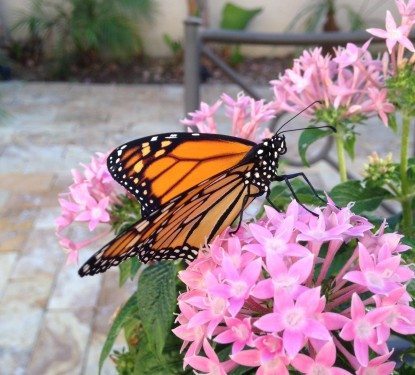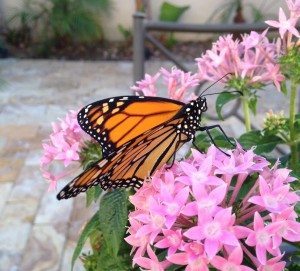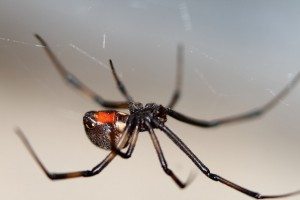Raising Healthy Monarch Butterflies
The 6 Common Monarch Diseases
Raising healthy monarchs is no picnic, and in fact, may be quite difficult until you really get it down. It took me LOTS of trial and error when raising these beauties for the first time. I didn’t have any guidance, learned everything on my own, did my own research, and discovered LOTS goes on with these guys. No wonder only 10% of monarchs survive in the wild!!
(Warning, there are some graphic images below so proceed at your own risk)
I have had a lot of questions regarding issues going on with monarchs so I hope you find this helpful. My goal here is to help you to raise healthy monarchs so that you don’t have to go through the horrifying experience I did when I first started.
There are 6 dreaded issues that can occur in these beauties; HOWEVER, they can ALL be avoided just be taking a couple precautions.
1. Tachinid Flies
This is what attacked my entire first batch of monarchs. I initially had my monarch habitat outside. I saw a tiny fly inside the habitat and thought nothing of it. Boy was I in for a big surprise…..
Tachinid flies are hard to differentiate between other flies. That’s why I bring ALL my eggs inside to prevent these horrifying things from killing my babies. What happens is these flies literally inject their eggs into the monarch caterpillar and use the caterpillar as a host. The caterpillar has no clue what just hit him and goes about its daily business eating and sleeping, until it goes up to J and pupate. This is where you will discover if your caterpillar has been a victim or not. If it is a victim and it makes it to J phase, it may not make it to pupation. You may notice it hanging limp, almost deflated and squishy. And if it does make it to pupation, within a day or two, you may notice some brown spots on the chrysalis or even see a mucous string hanging from it which the tachinid fly maggots use once they eat themselves out of the caterpillar. They will slide down on their string and go find a pupation place for them to turn into flies. If you see these guys, squish these bad boys! You don’t want these things around your monarchs. They are absolutely deadly.
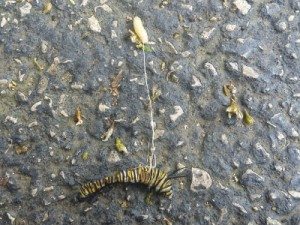 This is a maggot towing its hosted caterpillar with its mucous string. Flies can lay up to 8 eggs in one caterpillar!
This is a maggot towing its hosted caterpillar with its mucous string. Flies can lay up to 8 eggs in one caterpillar!
 Here is a brown chrysalis that has been infected by tachinid flies.
Here is a brown chrysalis that has been infected by tachinid flies.
So how do we go about this issue? Bring in your eggs. I personally like to watch mama butter lay her eggs and gather them as she is laying them. That way I am 100% positive that they are safe in my hands. Also, you can gather the itty bitty caterpillars that you see, instar 2 and smaller.
2. Ophryocystis elektroscirrha (OE)
OE is a spore that the caterpillars ingest on milkweed. Once ingested, the spores multiply immensely inside the caterpillar causing weakness, disfigurement, and even death. It is almost impossible to determine this in a caterpillar, but once it turns to chrysalis or even a butterfly if it actually emerges, here is where you can watch it and determine for yourself.
In chrysalis, you can be aware of any little black dots that appear. But I have really discovered it once the emerge. Either the butterfly cannot emerge completely from its chrysalis and gets stuck and dies, (I have assisted some who have struggled getting out of their chrysalis before), they keep falling off once emerged and can’t seem to keep their grip to dry their wings, or it does emerge and it’s wings do not hang down nicely. (You can test for OE as well with a microscope, but I won’t go into that now. That’s a completely different post.) Instead, the wings remain small and crinkled, the abdomen may still remain bloated as well, and they most likely will never fly.
You can do a couple things here: Either you separate it, feed it, and let it live out its life as a pet of yours, OR if it just cannot feed itself and can’t do anything on its own, it may be safe to say that we can euthanize. Euthanizing is completely last resort as we are doing our best to conserve these beauties. But the best way to euthanize is to put it in a baggie and stick it in the freezer. I know, heartbreaking…..
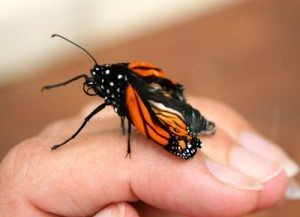 Here is an indication of OE, wrinkled up wings and large abdomen.
Here is an indication of OE, wrinkled up wings and large abdomen.
The biggest thing you can do here is to be sure you’re feeding your caterpillars clean milkweed. Wash your leaves or plants thoroughly before serving it to your babies. Also, don’t let your butterflies hatch over your caterpillars or milkweed. The spores can spread like glitter that has been blown in the wind. Another way to keep your caterpillars healthy is by cleaning out their frass daily and keeping the cages clean. I disinfect my cages after EVERY batch to prevent disease. You can also cut your plants back a couple times a year to get rid of any infected leaves, starting your plants nice, fresh, and full.
3. Nuclear Polyhedrosis Virus (NPV)
NPV is also known as Black Death. This is a yucky one. You might see your babies deflate, turn black, and then liquify. If you see one of your chrysalis’ turn black but don’t see any wings, and you know it’s too soon for it to turn to butterfly, you may need to dispose of it quickly. If it falls, and splatters, the stench is wretched, so try not to let it break.
Some tips on how to avoid this is to use a mesh cage that has good air flow and allows moisture to evaporate. Added moisture on your plants or in your cage creates bacteria, and if that bacteria is ingested, your caterpillars can be facing a deadly disease. Again, keep the frass cleaned or vacuumed up. You can even wipe down and dry your cages daily. If you notice some caterpillars acting funny, leaking fluid, or not eating (apart from molting) for more than 24 hours, separate them so as not to infect the others…and if you have to separate some caterpillars, be sure to replace the milkweed that the healthy caterpillars are eating to prevent further disease.
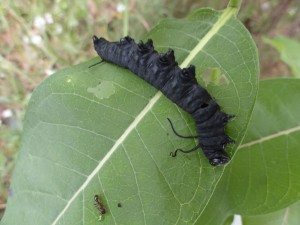 Caterpillar with NPV/Black Death
Caterpillar with NPV/Black Death
 Chrysalis with Black Death, and remember, the stench is awful!
Chrysalis with Black Death, and remember, the stench is awful!
4. Poisoned Milkweed
Milkweed is a toxic plant, toxic to people, animals, and other insects. Monarchs host on milkweed because it has just enough toxicity to deter predators. But we’re talking about milkweed that has been treated with pesticides. Milkweed that has been treated with pesticides is absolutely toxic to your caterpillars, and they will not survive. Be sure you are getting organic milkweed from your nursery.
So how do we know if our milkweed is organic or not? Sometimes it takes some experimentation. I’ve had local nurseries tell me that their milkweed has not been treated with pesticides, yet all my caterpillars fell off of it and died. Never again will I go to that nursery, and I’ll tell everyone I know not to go there in my area. So do some research. Find some local (or far away, whichever has organic!) nursery that supplies organic milkweed, and stock up! My belief is, you can never have enough milkweed. And if someone tells you otherwise, then get new friends LOL JK But seriously, do your homework. A good way to see if your milkweed is organic or not is to see if it if has any bugs on it, like the milkweed beetles or aphids. If it does, then you should be good. If caterpillars are living off it, that’s another good indication that the plant is safe. You can also plant your own milkweed, or purchase from a liable online source that is part of saving the monarchs.
5. Dehydration
Dehydration isn’t a disease, but it is a common problem. Dehydrated monarchs can get stuck inside their chrisalids which can cause deformation and even death. They may also have problems in the metamorphosis phase of chrysalis.
Here’s what you can do to help: You can do a little spritz of water on the milkweed and caterpillars. Our caterpillars need hydration starting from the egg stage.
6. Other Predators
There are many other predators that can take over your monarchs as well. When I had mine in their outdoor habitat, I had a rat or a mouse chew through the netting and devour about 20 of my big fat caterpillars. It just had a feast. (I bet that rat or mouse was really feeling sick afterwards….remember, the caterpillars milkweed which has a toxic milk). And just the other day I noticed a brown widow spider hanging out INSIDE my INDOOR habitat!!! Yup, spider will get your babies too if you’re not careful. We took care of that bad boy real quick. He was hiding under the rim of the pot and came out at night, so be sure to check your pots (underneath them as well for slugs….yes I’ve even had slugs get a baby cat before too). So if you’re more comfortable doing this, feel free to just bring in cuttings from our outside garden and rinse them thoroughly. They’re easier to inspect for little critters as well.
I hope this was helpful for you! Be sure to follow me and subscribe for more monarch-saving posts. I will share whatever has helped me so that you can have more beautiful monarchs. Have a blessed rest of your day!

